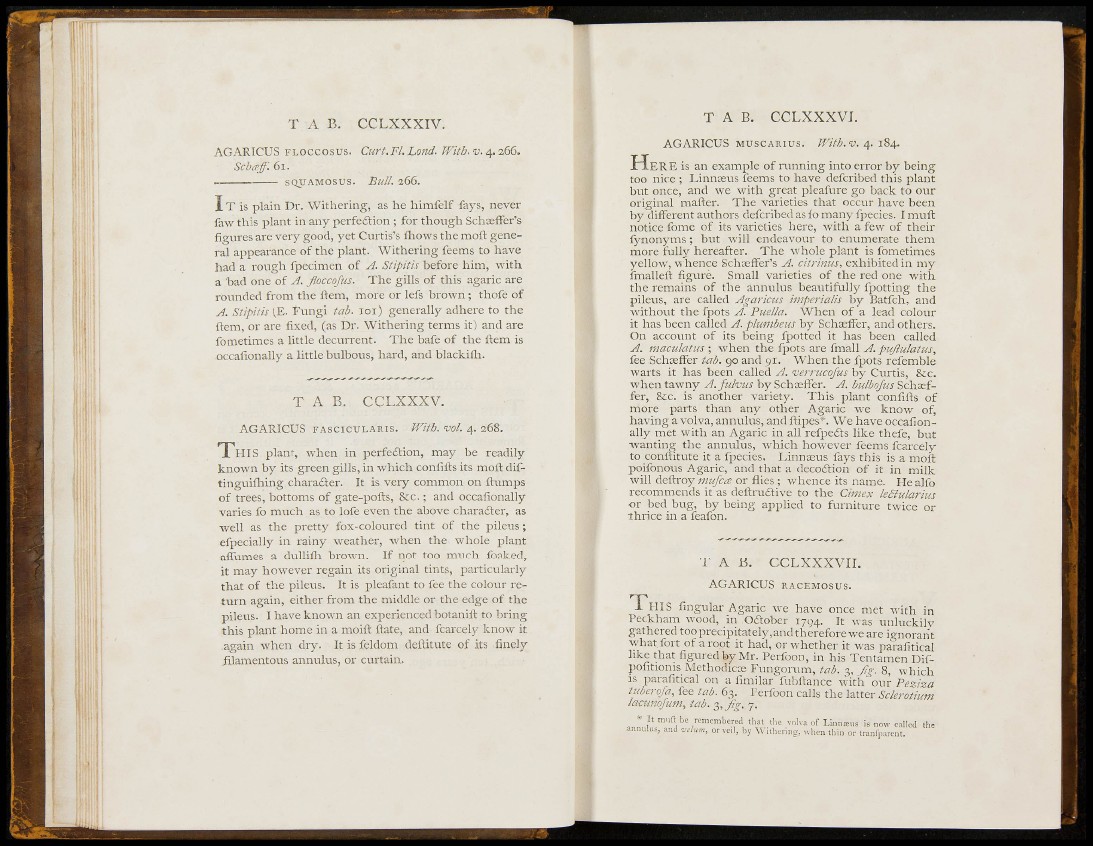
T A B . CCLXXXIV.
AGARICUS FLOCCOSUS. Curt.Fl. Land. With. v. 4. 266.
Sc/jof: 61.
SQUAMOSUS. Bull. 266.
I T is plain Dr. Withering, as he himfelf fays, never
faw this plant in any perfeition ; for though Schoeffer's
figures are very good, yet Curtis's fliows the moft general
appearance of the plant. Withering feems to have
had a rough fpecimen of J. Stipitis before him, with
a bad one of J. floccojus. The gills of this agaric are
rounded from the ftem, more or lefs brown; thofe of
A. Stipitis (E. Fungi tab. loi) generally adhere to the
ftem, or are fixed, (as Dr. Withering terms it) and are
fometimes a little decurrent. The bafe of the ftem is
occafionally a little bulbous, hard, and blackiili.
T A B . CCLXXXV.
AGARICUS TASCICULARIS. With. vol. 4. 268.
T H I S plant, when in perfeftion, may be readily
known by its green gills, in which confifts its moft diftinguifliing
charafter. It is very common on ftumps
of trees, bottoms of gate-pofts. See.; and occafionally
varies fo much as to lofe even the above charafter, as
well as the pretty fox-coloured tint of the pileus;
efpecially in rainy weather, when the whole plant
affumes a dullifli brown. If not too much foaked,
it may however regain its original tints, particularly
that of the pileus. It is pleafant to fee the colour return
again, either from the middle or the edge of the
pileus. I have known an experienced botanift to bring
this plant home in a moift ftate, and fcarcely know it
again when dry. It is feldom deftitute of its finely
filamentous annulus, or curtain.
T A B . CCLXXXVI.
AGARICUS MUSCARIUS. With. v. 4. 184.
H e r e is an example of running into error by being
too nice ; Linnosus feems to have defcribed this plant
but once, and we with great pleafure go back to our
original mafter. The varieties that occur have been
by diiferent authors defcribed as io many fpecies. I muft
notice fome of its varieties here, with a few of their
fynon^^ms; but will endeavour to enumerate them
more fuUy hereafter. The whole plant is fometimes
yellow, w hence Schaeffer's A. citrinus, exhibited in my
fmalleft figure. Small varieties of the red one with
the remains of the annulus beautifully fpotting the
pileus, are called Agaricus imperialis by Batfch, and
without the fpots A. Puella. When of a lead colour
it has been called A. plumbeus by Sch®fFer, and others.
On account of its being fpottcd it has been called
A. maculutus ; when the fpots are fmall A. pujiulatus,
fee SchasfFer tab. 90 and 51. When the fpots referable
warts it has been called A. verrucojus by Curtis, &c.
when tawny A.fulvus by SchasfFer. A. bulbojus Schaeffer,
&c. is another variety. This plant confifts of
more parts than any other Agaric we know of,
having a volva, annulus, and ftipes*. We have occafionally
met with an Agaric in all refpefls like thefe, but
wanting the annulus, which however feems fcarcely
to conftitute it a fpecies. Linnasus fays this is a moft
poifonous Agaric, and that a deco6tion of it in milk
will deftroy mufca: or flies; whence its name. He alfo
recommends it as deftruaive to the Cimex kaularius
or bed bug, by being applied to furniture twice or
ihrice in a feafon.
T A B . CCLXXXVII.
AGARICUS RACEMOSUS.
T H I S fingular Agaric we have once met with in
Peckham wood, in Oftobcr 1794. It was unluckily
gathered too precipitately, and therefore we are ignorant
what fort of a root it had, or whether it was parafitical
like that figured by Mr. Perfoon, in his Tentamen Difpofitionis
Methodicas Fungorum, tab. 3, fig. 8, which
IS parafitical on a fimilar fubftance witli'^our Peziza
tuberofa fee tab. 63. Perfoon calls the latter Sclerotium
la'CunoJum., tab. 7.
* It muft be rcmcmberetl th.it. the volva of Lbnaus is now cillod the
annulus, and -jclmn, or veil, by ^\•¡thcring, when thin or tranfparent.